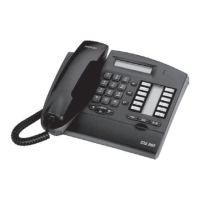File
9
PERMANENT LOGICAL LINK (PLL)APPLICATIONS
Ed. 04 3/4Réf. 3EH 21000 BSAA
CONFIGURATION
Preliminary
Before configuring the PLL, the installer must:
- define the S0 and T0 accesses
- check that the interfaces to be used are present in the "Subscribers/Basestations List" screen (for S0
interfaces) and the "External Lines" screens (for T interfaces)
Creating a PLL
To create a PLL, proceed as follows:
- choose the PLL caller from the list of declared accesses presented in the left-hand part of the win-
dow.
- enter the TEI of the caller PLL (SAPI = 16 is displayed, this value is not modifiable):
• for an external access, the TEI is given on subscription by the public network operator and is
between 0 and 63 inclusive.
- for an internal access, the TEI is between 1 and 63 inclusive (depending on the configuration
of the terminals).
- choose the PLL destination from the list of declared accesses presented in the right-hand part of the
window.
- enter the TEI of the destination PLL (follow the same procedure as for the TEI of the caller PLL)
- click Add to establish the connection. If all the checks are OK (see below), the connections are ad-
ded to the list of existing PLLs.
Checks
- The system can contain a maximum of 32 PLLs.
- The system cannot contain PLLs between 2 external accesses.
- The caller and the destination of the same PLL cannot be one and the same (same physical address
and same TEI).
- 4 TEIs per basic access (S0/T0), 16 per primary access (T2); 2 PLLs associated with different acces-
ses can have the same TEI (there is no check at MMC-PM5 level).
Overflow
It is possible to overflow onto a second destination if the initial destination is busy by configuring the
same caller with 2 different called parties.
Nota : Once declared, an ePLL or iPLL is bi-directional, i.e. either interface can initiate a call.
- by MMC-PM5 (Expert View), select: Subscribers Misc. -> Permanent Logical Link

